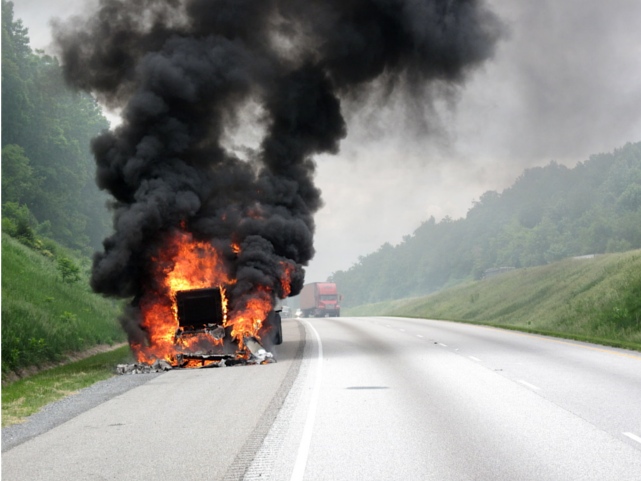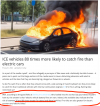The Auto Industry Finally Has a Plan to Stop Electric Vehicle Fires
EVs can burn for days, firefighters have little or no training to deal with them, and conventional equipment isn’t effective. But new technology is being developed that should make all the difference.
Photo collage with images of an EV a car on fire and a fire extinguisher.
PHOTO-ILLUSTRATION: WIRED STAFF; GETTY IMAGES
Save
Last month, a Mercedes Benz EQE 350 electric vehicle caught fire in a South Korean apartment building’s underground parking garage. Reportedly, 23 people were sent to the hospital and approximately 900 cars were damaged. The fire reached temperatures of more than 2,700 degrees Fahrenheit (1,500 degrees Celsius), and took firefighters almost eight hours to extinguish.
The incident led to a series of swift policy changes in the country, including the acceleration of a planned EV battery certification program and new rules in Seoul that should prevent owners from “overcharging” their vehicles in underground parking garages. It has also pushed automakers to do something they wouldn’t normally: reveal who makes the batteries inside their electric cars. (In early September, the South Korean government said it would require automakers to disclose this often secret information.)
Data from the National Transportation Safety Board, the US’s independent federal investigation agency, shows that the risks of electric vehicle battery fires are low. In fact, very low. An analysis of that data by one insurance company suggested that more than 1,500 gas cars catch on fire per 100,000 sales, compared to just 25 electric vehicles.
On some level, fire is a risk of any kind of battery technology. Professionals talk about the “fire triangle”—the three-ingredient recipe for ignition. Fire needs oxygen, a spark, and fuel. Because the point of a lithium-ion electric vehicle is to store energy, the fuel is always there. EV batteries are meant to be tightly packed and isolated from other parts of the car, but an incident like a catastrophic crash might quickly introduce oxygen and heat to the brew.
Building a Fire-Proof(ish) Battery
Some battery makers have taken steps to reduce the risk of their batteries catching fire. The first is to create stringent manufacturing processes and standards. This is important because any sort of flaw in a battery could lead to an inferno, says Venkat Srinivasan, who studies batteries and directs the Argonne Collaborative Center for Energy Storage Science at the US’s Argonne National Laboratory.
To understand why battery manufacturing matters to fire risk, you have to understand the basics of lithium-ion batteries. The battery’s anode and cathode store lithium, and they are connected by an electrolyte, a liquid chemical that passes lithium ions between the two to store or release energy. If, say, a tiny particle of metal gets into that electrolyte through an unclean manufacturing process, and it keeps getting electrified as the battery charges up and down, it could create a spark, open the battery cell, and allow oxygen to come rushing in and possibly expose the entire battery pack to fire.
These sorts of battery-making screw-ups do happen. In August, Jaguar told some 3,000 owners of its 2019 I-Pace SUV to park their vehicles outside because of fire risk, which was linked to three fires. The manufacturer behind those vehicles’ packs, the South Korean firm LG Energy Solution, has been subject to a US road safety probe since 2022. BMW, General Motors, Hyundai, Stellantis, and Volkswagen have all recalled vehicles over battery risks (some of them in hybrid rather than all-electric vehicles). But these situations are rare. Through solid manufacturing processes, “one can never make the risk of fire absolutely zero, but good companies have minimized the risk,” says Srinivasan.
Less Fire-y Chemistries
The good news is that less-fire-prone batteries are already rolling around in cars, thanks to specific battery chemistries that are harder to ignite. Since the first Tesla hit the road in 2008, the standard electric vehicle battery has been made primarily from nickel and cobalt. Batteries with this makeup charge quickly and hold lots of energy, which is great for EV use because drivers of vehicles that use them enjoy longer ranges and faster top-ups. They’re also more likely to enter “thermal runaway” at lower temperatures, in the 400- to 300-degrees Fahrenheit (210 to 150 degrees Celsius) range.
Thermal runaway is a state in which lithium-ion batteries enter a kind of fire doom loop: A damaged battery cell produces heat and flammable gases, which in turn produces more heat and flammable gases, which begins to heat nearby battery cells, which release more heat and gas. The fire then becomes self-sustaining and hard to put out.
Enter lithium-iron phosphate, or LFP, batteries. LFP batteries enter thermal runaway at higher temperatures, around 520 degrees Fahrenheit (270 degrees Celsius), because the bonds between iron and phosphate are stronger than the bonds between cobalt and oxygen. They’re also slower to degrade than other chemistries. And, finally, the powerful advantage from automakers’ point of view: They’re cheaper to make.
Many automakers have shifted towards LFP batteries. Tesla Models 3 and Y purchased in the US after 2022 have them, and so do Rivians and Fords. Now Stellantis and Mercedes Benz are reportedly pivoting to LFP production too. The attraction of LFP batteries has also grown as automakers (including Tesla) have turned to cell-to-chassis manufacturing, which integrates the battery into the structure of the car. Automakers using this newer technique mostly use LFP batteries. “For the concept to be safe, the chemistry needs to be safe,” says Srinivasan, the researcher.
Battery makers say other design tweaks can decrease the likelihood of thermal runaway, and therefore fire. CATL, the leading battery manufacturer in the world, said earlier this year that a new “smoke electric isolation” design separates a battery cell’s electrical connection from its smoke exhaust channel, which makes it less likely that a fire within a cell will spread to other parts of a vehicle’s battery pack.
Nixing the (Flammable) Liquid
The true technological hero of less fire-y batteries is just over the horizon: solid state. “Solid state” refers to a few sorts of battery technologies, but the ones with the lowest fire risk use a solid electrolyte, rather than a liquid one, to separate the anode and cathode, which isn’t flammable. “That removes a big problem,” says Srinivasan.
For years, automakers and battery developers have hyped the prospect of solid-state batteries, but they have yet to show up in production cars. The good news is that solid-state batteries are performing better than ever, says Srinivasan. “It’s night and day in terms of what’s happened in the last five years.” The bad news is that the great performances are happening in the lab. Like most new technologies, solid-state batteries face a standard list of hurdles: building supply chains to support their manufacture; perfecting the processes for mass production; and competing against lithium-ion tech. Getting there could take years.
Fortunately, the world is also thinking more seriously about how to tamp down on electric vehicle fires after they’ve started. Many lithium-ion battery fires are caused by cheaper, aftermarket batteries that don’t go through stringent quality control. (See: a rash of ebike fires in New York City.)
US public officials have urged customers to only buy batteries that have been certified by nationally recognized laboratories, like Underwriters Laboratory (UL), and to dispose of lithium-ion batteries through take-back programs such as those administered by Call2Recycle, rather than leaving them out for trash collectors. Allowing a hulking EV battery into the conventional trash system may sound wild, but a top location for EV battery-related fires has been salvage yards, where damaged and incorrectly-disposed-of batteries have been abandoned.
Products to tamp down already ablaze batteries abound. Fire blankets are meant to reduce the smoke damage of serious fires, including those set off by Li-ion batteries. Some sellers offer extinguishers specially made to put out electric vehicle battery fires. The Nevada-based company E-FireX uses an agent called “TRPL-E” that the firm says is designed to be kept in places like garages and truck beds and to tamp down on thermal runaway until fire professionals can intervene.
Jesse Corletto, a former firefighter and the head of E-FireX, says interest in the product has shot up in the last few years, with potential customers including firefighting and police departments, first responders, the military, maritime professionals, and even regular EV owners. “We have to keep up with the technology that's out there,” says Corletto.
Future Firefighting
Globally, fire groups are focused on preparing firefighters and other first responders for the unique aspects of lithium-ion battery fires. In the US, the nonprofit National Fire Protection Association offers online and in-training lithium-ion battery fire training for fire professionals, including a new simulated training experience funded in part by the US Department of Energy. Earlier this year, the southern Australia state of New South Wales required firefighters to take online electric vehicle fire training after four lithium-ion batteries caught fire there in one day. (The governing body did note that such fires were very rare.)
Firefighters could also use some help from manufacturers to prevent out-of-control blazes, says Emma Sutcliffe, the project director of EV Fire Safe, a private firm founded by the Australian government to research EV fire risks. Some auto- and battery-makers are great at sharing free and easy-to-access “emergency response guides,” which take fire professionals through what they need to know to stop their products’ battery fires. Sutcliffe highlights Tesla as a company that is proactive about sharing with fire departments.
Other manufacturers have been savvy at making it easy for firefighters to get at fires once they’ve started. Renault builds a “fireman access” port into its EVs and hybrids, which allows first responders to pump water directly into an on-fire battery. (Sutcliffe notes that, while handy, the port is only useful in the early stages of a fire, before it has expanded beyond the pack.)
Other automakers make it easy for firefighters to cut a battery’s power to other parts of the vehicle, to ensure that they won’t hurt themselves while dealing with a battery blaze. Teslas have a “first-responder loop” that can be cut to shut down their high-voltage systems. Other cars come with pull fuses or plugs. “We’d love all manufacturers to have a standard way to cut power,” says Sutcliffe.
Gear
Upgrade your life with our buying guides, deals, and how-to guides, all tested by experts.
Sign up
By signing up you agree to our User Agreement (including the class action waiver and arbitration provisions), our Privacy Policy & Cookie Statement and to receive marketing and account-related emails from WIRED. You can unsubscribe at any time. This site is protected by reCAPTCHA and the Google Privacy Policy and Terms of Service apply.
On-the-horizon regulations may end up teaching electric vehicle customers more about the fire risks of the batteries in their cars. In 2027, the European Union will begin to enforce “battery passport” rules, which will require battery makers to maintain documentation about where a battery was made, how it’s been tested, and whether it contains recycled content. In June, Volvo got ahead of things by becoming the first automaker to launch a battery “passport” for its flagship electric EX90 SUV.
The regulation is mostly about keeping automakers honest when it comes to the carbon footprints of their EVs, but a happy side effect may well be a better view into the manufacture origins and ingredients inside car batteries.





